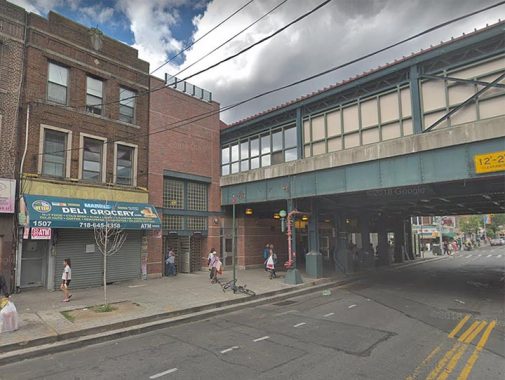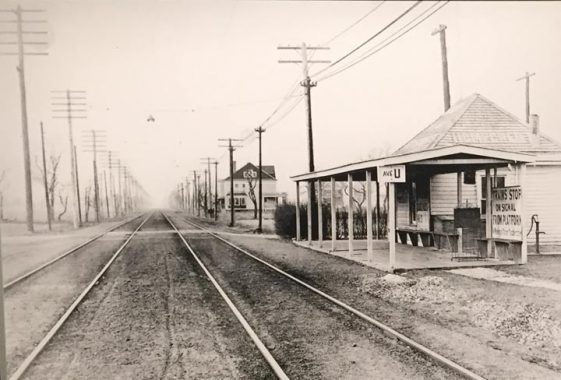I was fascinated by a couple of photos I saw at the NYC Transit Museum when I visited it in January of the Brighton Line, a steam rail line that ran north-south in Kings County, serving mainly to bring commuters from the Coney Island and Brighton Beach shorelines to the els in northern Brooklyn, and ultimately over the Brooklyn Bridge into Manhattan.
In 1877, the Brooklyn, Flatbush and Coney Island Railway was incorporated, opening the next year in 1878. It originally ran from the Prospect Park entrance at Flatbush and Ocean Avenues south to the Brighton Beach Hotel, built near the water’s edge.
After 1882, when the Long Island Rail Road took over a BF&CI competitor, the New York and Manhattan Beach Railroad, it found itself competing with itself for suburban railroad customers. The NY&MB had been created by LIRR chief Austin Corbin before that railroading giant assumed control of the LIRR, and accordingly, the LIRR evicted the BF&CI from its trackage at the end of 1883 after just six years in service. BF&CI service was truncated to the Bedford Terminal at Frankin and Atlantic Avenues, where there was a turntable for turning the steam engines.
No longer having a desirable northern terminal, the BF&CI was forced into bankruptcy and was reorganized in 1887 as the Brooklyn and Brighton Beach Railroad. The next year the Brighton Beach Hotel was moved inland–by railroad–to keep it from slipping into the sea. In 1896, the problem of what to do with the northern end of the line was solved when a ramp was built to connect new Kings County Elevated that ran along Fulton Street to the Brooklyn & Brighton Beach from a junction at Franklin and Fulton, bridging Atlantic Avenue and connecting to the Brighton several blocks south of that point.
The Fulton elevated ran from downtown Brooklyn over Fulton Street out to Jamaica and was completed in 1893; the connection with the Brooklyn & Brighton Beach completed in 1896 was built to carry the B&BB over its old partner, the LIRR, which was still operating at grade along Atlantic Avenue. This portion of the LIRR was itself submerged in a tunnel under this part of the avenue from 1903-1905. In 1896, the same year the B&BB was leased to the Kings County Elevated, a new entity was created to unite Brooklyn’s surface and elevated lines: the Brooklyn Rapid Transit Company, the BRT. The Fulton-Brighton Beach connection is known today as the Franklin Shuttle.
Beginning in 1905, the Brighton Beach was brought to its present-day arrangement by eliminating all grade crossings. The northern part would be on an elevated structure; south of about Prospect Place, trains would run in an open cut; and south of Foster Avenue, trains would run on an embankment created from land excavated to submerge the Bay Ridge Branch of the LIRR in its own open cut. Many cross streets would be depressed to travel under the embankment, but some, such as Avenues I and X, would stop at the embankment, vexing travelers to this day. Brighton Beach BRT service continued along the parallel LIRR Manhattan Beach branch while the grade crossing elimination project was underway.
Above we see what the Brighton line grade crossing at Avenue U looked like. Passengers for both northbound and southbound service could wait on the porch of the station building. Conductors took tickets from passengers once they had settled in the traincar.

The grade crossing was eliminated between 1905 and 1907 and the new Avenue U station opened on August 23, 1907. The commercial buildings on Avenue U were constructed following the opening of the station. The large canopy on the platform was added during station renovations in the early 2000s. The line serves the present Q train, which runs up Broadway and 2nd Avenue in Manhattan.
The Neck Road station, still known by that name today, is one stop south on the Brighton line. While locals call it Neck Road its proper name on street signs is Gravesend Neck Road. It’s avery old road, possibly going back to the colonial period, predating the street grid. This grade crossing was eliminated in 1905.
The handsome apartment buildings with retail on the ground floors are old indeed, but we can pinpoint their construction to shortly after 1907 when the new Neck Road station opened on August 23 of that year. Grade crossings were eliminated as Gravesend, which became part of NYC in 1898, anticipated increased commercial growth, population and traffic in the early 20th Century.
Check out the ForgottenBook, take a look at the gift shop, and as always, “comment…as you see fit.”
5/12/20
